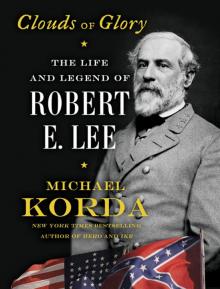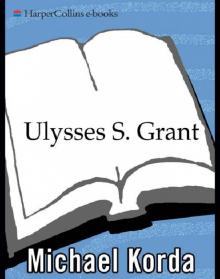- Home
- Michael Korda
Clouds of Glory Page 37
Clouds of Glory Read online
Page 37
On September 19 Lee rode south to the Kanawha valley, where yet another potential Confederate disaster seemed to be unfolding. An enemy advance there would threaten both the Virginia Central and the Orange and Alexandria railroads. Generals Wise and Floyd not only were contemptuous of each other, but now refused to cooperate at all; as a result, Floyd had fallen back with “his little army” under modest Union pressure, while General Wise refused to retreat from his position at Sewell Mountain, maintaining that he was determined to fight it out and was under no obligation to obey an order from General Floyd. Lee, finally aware that the missing element in the defense of northwestern Virginia was his own failure to impose his will on recalcitrant or incompetent generals, managed to get Floyd to move forward; but here too, as at Cheat Mountain, bad weather, scanty rations, and poor morale made it impossible to launch a convincing attack. For nearly four weeks Lee tried to sort out the mess that Wise and Floyd had made on their own in a key area, the loss of which would endanger two vital railways. Wise and Floyd were perfect examples of the danger of giving politicians not only the rank of general, but actual active command in the field. Wise was the more aggressive and courageous of the two; Floyd would bring disgrace on himself in a few months’ time by fleeing from Fort Donelson when Ulysses S. Grant surrounded and attacked it, abandoning his command to General Buckner—an episode about which Grant later wrote, “[Floyd] was no soldier, and possibly, did not possess the elements of one,” calling him “unfitted for command,” a judgment that seems moderate and was shared by both armies.
Oddly enough, it was the cautious Floyd whom Lee favored over the more impetuous Wise. On his advice President Davis had Wise recalled to Richmond, leaving Floyd in command. Fortunately for the Confederacy bad weather and timid generalship prevented the Federals from taking advantage of the situation, and with winter coming on Lee was able to stabilize a kind of front. This was something of a triumph for Lee, who had overcome chaos and a broken chain of command, and in the end he prevented a disaster by his presence.
The press gave Lee no credit. Floyd, a career politician, had a surer sense of public relations, as we now call it, than Lee, and managed to get his side of the story into print before Lee was back in Richmond again. Even Lee, who was seldom critical of anyone, took note of the fact that Floyd had “three editors” on his staff, grinding out praise for their general and blame for everyone else. The Richmond Examiner dismissed Lee as “outwitted, outmaneuvered, and outgeneraled,” and suggested that Floyd had been eager to fight but that Lee overruled him and allowed General Rosecrans to get away “unmolested,” pretty much the opposite of what had happened. The same newspaper also criticized Lee for devoting too much time to studying maps and planning, and complained that since Lee’s strategy had failed, “it will be useless to discuss its merits,” then went on to blame Lee for his “excess of caution.” The Charleston (South Carolina) Mercury accused him of being “a great General, who can never get up to the enemy,” and went on to ask, “Are the roads any worse for Lee than Rosecrans? The people are getting mighty sick of this dilly-dally dirt digging, scientific warfare, so much so, that they will demand that the Great Entrencher be brought back and permitted to pay court to the ladies.” One of Lee’s officers was quoted as saying that the army would never move forward “unless somebody puts a coal of fire on the back of that old terrapin Lee.” “Granny Lee,” “the King of Spades,” “the Great Entrencher”—Lee’s stock had plunged throughout the South, and he was now pitied and laughed at more than he was admired. He wrote to Mary, who was in Hot Springs “seeking treatment,” with just a touch of asperity: “I am sorry, as you say, that the movements of the armies cannot keep with the expectations of the editors of papers. I know they can regulate matters satisfactorily to themselves on paper. I wish they could do so in the field.” Lee would have agreed with Stephen Vincent Benét’s line about him, in the poem “Army of Northern Virginia,” “But God is the giver of victory and defeat.”
He had little to show for his four months in the field, but it was not time wasted. Given the sad state of the troops and their commanders in northwestern Virginia, he had managed to at least hold the line there, and stave off a Union advance. More important, he had learned a great deal. He was still unwilling to knock heads together, but this does not mean that he failed to recognize a fool or a mediocrity when he met one, and he succeeded in getting anyone who fell into either category adroitly moved to some other command, out of the way, as he did first with Wise and then with Floyd. It was one of Lee’s gifts—the ability to get rid of people he didn’t trust without a confrontation, so they often didn’t even realize what had happened until it was too late. He had also relearned the value of digging earthworks, much as the men hated doing it (for southern soldiers, it was “nigger work”) and despite the fact that people made fun of him over it. Earthworks had given Reynolds’s men on the crest of Cheat Mountain the ability to hold back a force many times their size, and earthworks had prevented Rosecrans from advancing in the Kanawha valley.
The war in the harsh terrain and bad weather of Virginia had changed Lee in many ways. He now understood the effect his presence had on the men, if not always on their officers. Naturally abstemious, he shared their hardships, lived on the same rations as they did, ate off a battered tin plate, lived under canvas even when a house was available, and when necessary slept in the open, wrapped in his overcoat. Although he was not a man who thought in those terms, his image was formed here, indelibly, for the ages. He had let his beard grow—a full, silvery gray beard that soon turned white and replaced all previous images of him. The man with the trim, dark mustache and the flowing Byronic locks was simply erased, so completely that earlier pictures of him seem those of another man altogether. He wore a simple Confederate uniform of his own design: a gray frock coat and waistcoat without braid or ornamentation; the polished leather leggings of a dragoon over boots and spurs when he was in the field, or gray trousers when he was not mounted. It was the plainest of uniforms, as much like that of his soldiers as he could devise. He was already famous for his superb calmness, his self-control, and the way he spoke to everyone from privates to generals in the same gentle voice, as if good manners meant more to him than anything else, which was indeed the case.
All the elements in Lee’s personality came together during those four grueling and disappointing months when he commanded an army in the field, even including the horse that would soon share his fame, for it was in what is now West Virginia that Lee first saw and determined to purchase Traveller, possibly the most famous and beloved horse in history:
. . . Why,
You’re weeping! What, then? What more did you see?
A gray man on a gray horse rode by.*
On few horses has so much praise been showered, and not only by Lee himself. In the words of Stephen Vincent Benét:
And now at last
Comes Traveller and his master. Look at them well.
The horse is an iron-grey, sixteen hands high,
Short back, deep chest, strong haunch, flat legs, small head
Delicate ear, quick eye, black mane and tail,
Wise brain, obedient mouth. Such horses are
The jewels of the horseman’s hands and thighs,
They go by the word and hardly need the rein.
They bred such horses in Virginia then,
Horses that were remembered after death
And buried not so far from Christian ground
That if their sleeping riders should arise
They could not witch them from the earth again
And ride a printless course along the grass
With the old manage and light ease of hand.†
Traveller was born near the Blue Sulphur Springs in Greenbrier County, Virginia (now West Virginia), and raised by Andrew Johnston. His original name was, of all things, Jeff Davis, and he was “of the Gray Eagle stock, and as a colt took first prize at the Lewisburg, Virginia, fairs in 1859 and
1860.” Years later, Major Thomas L. Broun recollected that he had placed the horse in Lee’s hands. Broun had authorized his brother, Captain Joseph M. Broun, “to purchase a good serviceable horse of the best Greenbrier stock.” After a lengthy search Captain Broun bought the four-year-old Jeff Davis for “$175 (gold value) . . . from Captain James W. Johnston, son of the Mr. Johnston first above mentioned.” Major Broun was serving, like his brother, in the Third Virginia Infantry in the “Wise Legion” encamped near Meadow Bluff, where he often rode the horse, “which was then greatly admired for his rapid, springy walk, his high spirit, bold carriage, and muscular strength.” When Lee took command of the Floyd and Wise “legions” he saw the horse “and took a great fancy to it.” Perhaps Lee was dissatisfied with his present horse Richmond, or perhaps he simply saw in Jeff Davis something he liked, but he made it clear to both Brouns that he was interested in the horse, though they were in no hurry to sell it. It was not until February 1862, when Lee, Captain Broun, and Traveller met up again in South Carolina, that Lee actually acquired the horse. Captain Broun, knowing how strong Lee’s interest in Jeff Davis was, offered “to give him the horse as a gift,” but Lee would not hear of that, although he agreed to take the horse for a week on trial to see how they got on together. The trial was successful. The Broun brothers then offered to sell the horse to Lee for what they had paid, but Lee insisted on adding $25, “to make up for the depreciation in our currency from September, 1861, to February, 1862”* (a first warning sign of the disastrous economic and financial consequences of secession).
Lee had several horses during the war, including Richmond; Ajax; an unnamed “brown roan”; and Lucy Long, who was purchased for him by J. E. B. Stuart (one of the great cavalry commanders of all time, and also a fine judge of horseflesh) and lived on to a remarkably old age, dying in 1891. But it was Traveller Lee loved most and rode most often, though others who rode him from time to time were less enthusiastic. Lee’s youngest son, Rob, complained of the difficulty of sitting to Traveller’s bouncy, “short, high trot” and remarked that he “was glad when the journey ended”—not surprisingly, since it was thirty miles long. In any event, the horse suited Lee, and his greatest pleasure after the war was to take Traveller out for a ride. Horse and rider are fixed together now in history and legend as they were in life. When Traveller died, he was, after some delay, buried where he belongs, a few feet from his master.
Even Jefferson Davis would later say that Lee “came back, carrying the heavy weight of defeat,” but Lee showed no sign of it. He quietly slipped back into his position as Davis’s chief military adviser, and on November 5 wrote to Mary that he hoped to meet her at Shirley, the Carter plantation on the James River, where she had gone after her “cure” in Hot Springs, on her way to the White House. But the next day he was ordered to take immediate command of the newly formed Department of the South, which had been created to protect the coastline of South Carolina, Georgia, and Florida. When news came that a large fleet of Federal warships and transports was at sea and bound for Port Royal, South Carolina, it was natural for Lee to be chosen, given his experience with fortifications, and his familiarity with the area itself. On the other hand, it is also possible that Davis, despite his professed admiration for Lee, was relieved to get him out of Richmond, where Lee remained a very visible object of criticism for what was widely viewed as his mishandling of the northwestern Virginia campaign. If Davis thought sending Lee south would solve this problem, he was wrong. Fear that Lee would lose the three southeastern states, as he had lost northwestern Virginia, led to protests that included a “round-robin” from South Carolina officers, and Davis was forced to remind the governors of Georgia and South Carolina that Lee was not only a full general but “the best man available.” This time, however, Lee insisted on being in undisputed command. His arrival in Charleston soon stilled any further protests. If, since the South still lacked a navy, he could not prevent the U.S. Navy from blockading the southeastern ports or from attacking Confederate fortifications from the sea, he at least prevented what might easily have been a catastrophe involving the loss of three states.
He established his headquarters at Coosawhatchie, near Port Royal Sound, where the Union fleet was already bombarding two Confederate forts. This time he quickly established his authority. It was at once clear to him that he could not defend the entire coastline of three states from attack, or even from small-scale landings. The U.S. Navy was able to sail anywhere without interference, and the shoreline, over 8,000 miles long, contained endless inlets, islands, and bays, any one of which might serve as a landing place. Only by the most arduous pressure on the three governors was Lee able to put together a force of of some 6,800 men—he would have had no arms for most of them had not a Confederate blockade-runner appeared in Savannah with a cargo of Enfield rifles.
Lee quickly set about inspecting his vast department. The fact that he covered 115 miles in one day, 35 of them on Traveller, gives some idea of his “grueling” pace. He came to the conclusion that he must withdraw troops and guns from the myriad of islands and waterways, which it was impossible to defend, and instead concentrate all his strength on the defense of Charleston and Savannah. He set about constructing an “inner line” of earthwork fortifications to protect the two ports and the railway that connected them, “an unromantic routine of duty, dirt and drudgery” for those doing the digging. This was a sensible strategy, though it did not please the owners of rice plantations or those who produced “sea island cotton,” many of whom had to abandon their homes, lands, and slaves to the enemy. Not only had Lee made the right decision militarily; his presence this time seemed to calm even those who wanted a full-scale battle rather than a careful defense scheme. It did not hurt that his father had been a dazzling hero as a cavalry commander in the Carolinas during the Revolutionary War. One South Carolinian, Paul Hamilton Hayne, described Lee in semireligious terms: “In the midst of the group, topping the tallest by half a head was the most striking figure we had ever encountered, the figure of a man seemingly about 56 or 58 years of age, erect as a poplar, yet lithe and graceful, with broad shoulders well thrown back, a fine justly-proportioned head posed in unconscious dignity, clear, deep, thoughtful eyes, and the quiet, dauntless step of one every inch the gentleman and soldier. Had some old English cathedral crypt or monumental stone in Westminster Abbey been smitten by a magician’s wand and made to yield up its knightly tenant restored to his manly vigor . . . we thought that thus would he have appeared, unchanged in aught but costume and surroundings.” Lee’s venerable appearance—he was in fact fifty-four, not fifty-six or fifty-eight—may have been due to his cares as the man responsible for the protection of three states and the Confederacy’s two major remaining ports, but the rest of Hayne’s somewhat overwrought description is notable for being the first to compare Lee to a knight of olden times, and even to a knight of the Round Table, for “a magician’s wand” is a clear reference to Merlin’s role at King Arthur’s court. In any case Lee is cast in the noble, heroic mold of mythic heroes of the past, the image that he would assume in the eyes of all southerners (and many northerners) early in 1862 and which has remained his to this day. Clearly, the image preceded the victories that would justify it, and it was not just the way his countrymen wanted to see Lee, but to some degree the way they wanted to see themselves. The North was viewed by many southerners as money-grubbing and corrupt, a place of rampant industrialism, big banks, mass immigration of foreigners, and disregard for the traditions of America, and in favor of blind “progress,” while the South was a bucolic paradise of small farms, stout yeomen, and courtly aristocrats, all hewing to the untarnished ideals of Washington and Jefferson—a simplified, romantic vision in which the reality of slavery played no part. It was a contest of Camelot versus the “dark Satanic mills,” and it would be Lee’s fate to play the role of Sir Galahad.
It must be said at once that Lee had no part in creating this legend, nor would his modesty have enabled him
to accept it, but it was to become a major weapon of the Confederacy—in its final days its only weapon. So it is interesting to see the web of myth already being drawn around Lee, as it would be drawn around even his new horse: for Traveller, only just purchased and renamed, would also play his part in the legend, as Lee’s “noble steed.”
In the meantime, his biggest challenge was to overcome his soldiers’ reluctance to dig. Despite this, he created a series of fortifications that daunted even Brigadier General William Tecumseh Sherman. Lee was enraged that the U.S. Navy sank “half a dozen old ships” to block the main channel to Charleston, an “achievement . . . unworthy of any civilized nation,” as Lee described it in a rare burst of anger. He was relieved that Mary Lee had finally settled at White House, and he paused to pluck some violets from the garden of the deserted house he occupied in Coosawhatchie to send his daughter Annie. Lee’s concern for his family was magnified by his anger at the behavior of Union forces, which he feared would be extended to them in the form of “ruin and pillage,” if not worse, though in fact Mary and their daughters were treated with considerable courtesy when they fell briefly into the hands of the enemy. He wrote to Mary again on Christmas day, urging her to put Arlington out of her mind. “As to our old home, if not destroyed, it will be difficult ever to be recognised. . . . With the number of troops encamped around it, the change of officers, etc., the want of fuel, shelter, etc., and all the dire necessities of war, it is vain to think of its being in habitable condition. I fear, too, books, furniture, and the relics of Mount Vernon will be gone. It is better to make up our minds to a general loss. They cannot take away the remembrances of the spot, and the memories of those that to us rendered it sacred.” This was sensible, if not welcome, advice. With bleak realism, he urged her not to believe rumors that Great Britain would recognize and support the Confederacy: “We must make up our minds to fight our battles and win our independence alone. No one will help us.”

 Passing
Passing Another Life
Another Life Clouds of Glory
Clouds of Glory Hero: The Life and Legend of Lawrence of Arabia
Hero: The Life and Legend of Lawrence of Arabia Cat People
Cat People Hero
Hero With Wings Like Eagles: A History of the Battle of Britain
With Wings Like Eagles: A History of the Battle of Britain Ulysses S. Grant
Ulysses S. Grant